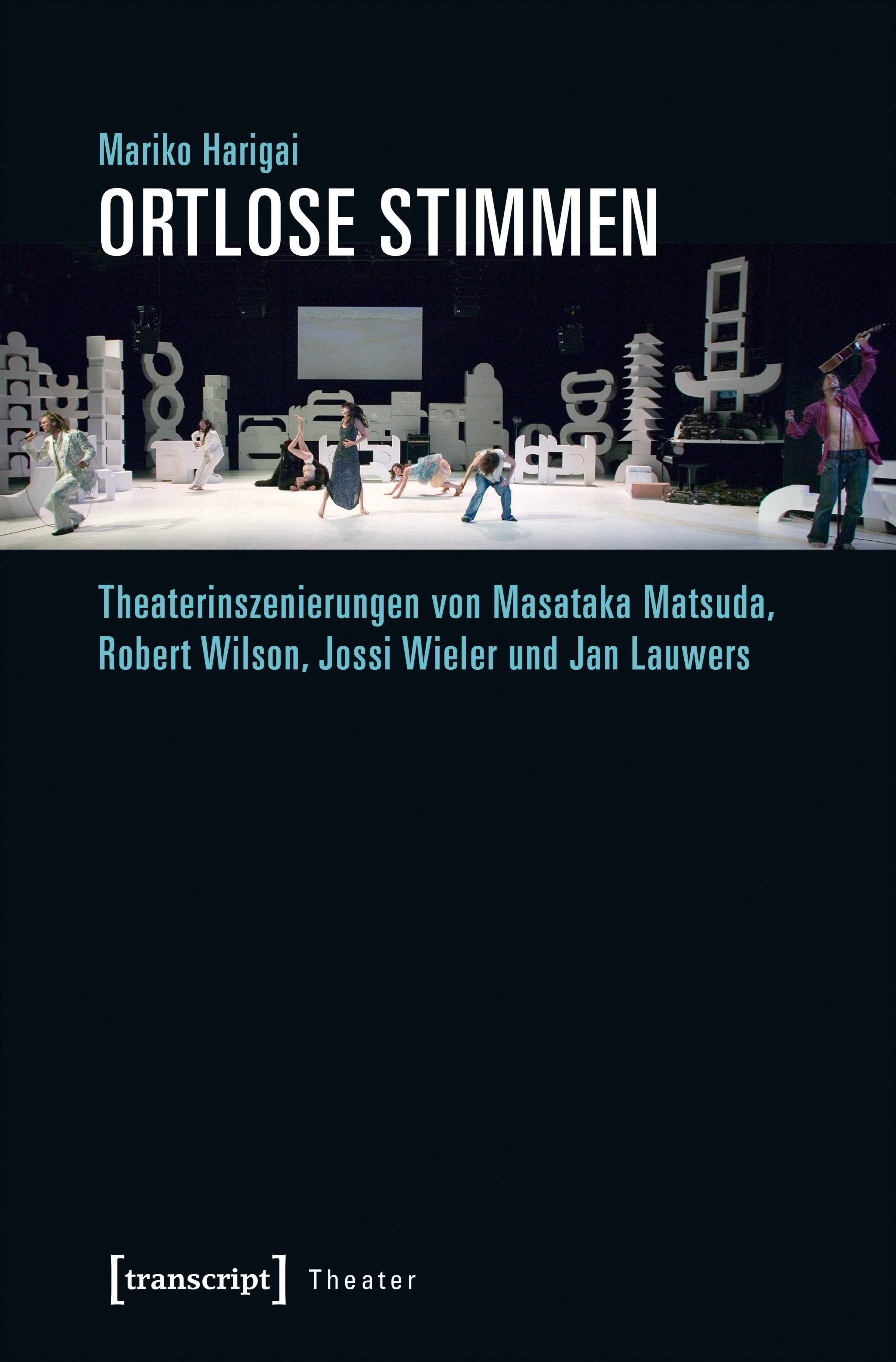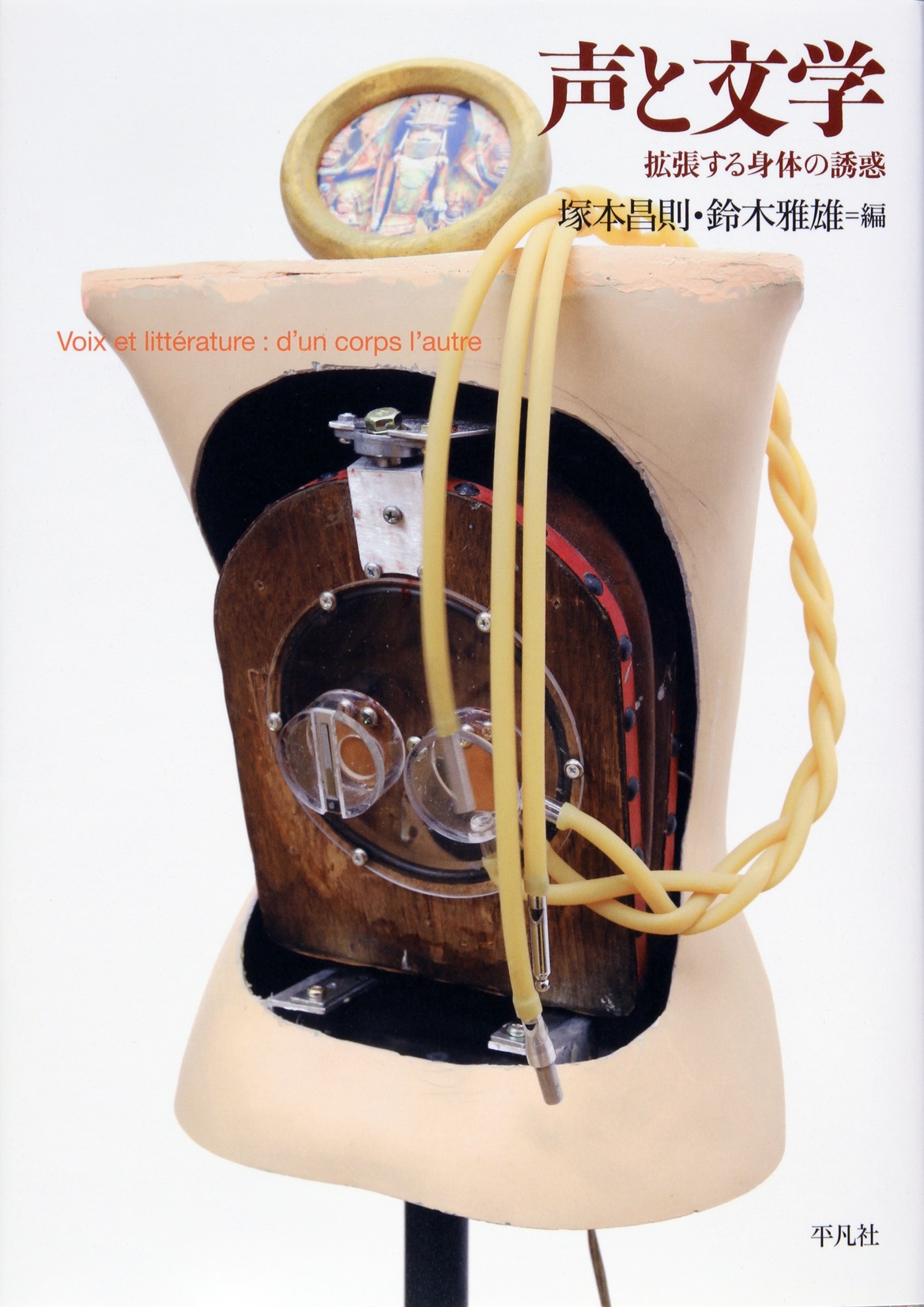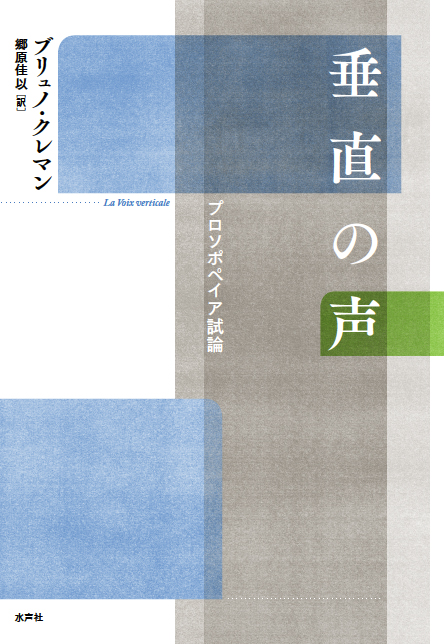
Title
Theater- und Tanzwissenschaft Ortlose Stimmen Theaterinszenierungen von Masataka Matsuda, Robert Wilson, Jossi Wieler und Jan Lauwers
Size
298 pages
Language
German
Released
March 15, 2018
ISBN
9783837640793
Published by
transcript
Book Info
See Book Availability at Library
Japanese Page
The theatre is a heterogeneous, dynamically generated place/space. For an analysis of the dynamic generation process of this place, voices in contemporary theatre are an especially productive object of study. Voices not only make us imagine places through language, but they also produce the places, and let us hear their own transience and fluidity so that the imagined or produced places are dissolved simultaneously.
The voice in itself is placeless; it has no place of its own which could be identified by a name because it fades away the moment it becomes sound and thus can never be “fixed.” The voice is the trace of the caller, whom it leaves behind even when it becomes sound, while it is accessible to the listener only as a trace and is therefore always differently heard. Although the voice works as an index, its identity is not given a priori, it is always constituted in retrospect. The voice cannot be located either with the speaker or the listener, but it always resides in a space between. Through its bodily nature, the voice structures in a processual way the particular relations between the callers, the listeners, and the imagined places. Voices which bring such properties to the fore are termed, in the present thesis, placeless voices.
Though the voice in itself is placeless, it creates a listening space; thereby, specific locations arise within a dynamic process – the origin of the voice or the position of the callers and the places of gathering or point of contact of the callers and listeners. This process, in which socially, politically, or geographically predetermined places are dissolved and theatrical places of gathering are created, is analyzed in the thesis with reference to specific, strikingly staged placeless voices, some variants of which are distinguished as “topological vocal gestures.” They structure different relations between the callers, the listeners, and the imagined places within the theatrical listening space. In the first part, it is examined how the places of origin of the voices, which are often identified with politically, geographically, or socially determined places, are formed and dissolved in a processual manner. In the second part, it is shown how the voices’ calling upon us create theatrical gathering places.
Since the voices are perceived not as something present, the places which are vocally generated are recognized as such only by the repetition of the different. Topological vocal gestures therefore correspond to self-repeating gestures. Each topological vocal gesture leads to a particular repetition with difference. Placeless voices hold places together only through their repetition. Topological vocal gestures in general show, especially in the form of repetition with difference, that origins or homes do not exist a priori, but are generated in a process. Through the voices, callers and listeners do not merge into a single community, but the voices are shared / divided (partage) by both sides – with difference.
By drawing on case studies from Japanese, German, and Belgian contemporary theatre and by referring to theories by Gilles Deleuze/Félix Guattari as well as Roland Barthes, this study shows – from a performance analytical perspective – that the repetition with difference, which makes a vocal place possible in the first place, does not only mark a physical, acoustically perceptible repetition, but also appears as an affective one; it makes the voice constitutively placeless while connecting the listener with a place. This is because the voice produces a specific, affective location: atopia. Atopia is the unqualifiable place which attracts the callers while generating different points of contact between the listening I and the calling you. The atopia becomes the clue which can lead us as listeners to the position of the callers and to the contact point between callers and listeners.
(Written by HARIGAI Mariko, Associate Professor, Graduate School of Arts and Sciences / 2023)
Table of Contents
HINFÜHRUNG
Einleitung: Die »Reise« im stimmlichen Theaterraum | 15
1. Szenen. Gespielte Orte | 27
1-1. Gemeinplatz. Hiroshima-Hapcheon von Masataka Matsuda | 27
1-2. Standpunkt.Voiceprints City —— Letter to FATHER von Masataka Matsuda | 36
1-3. Atopos. Disharmonie der monadischen Welt | 44
2. Theorie der »ortlosen Stimmen« | 51
2-1. Stimmliche Relationen | 51
2-2. Ort und Raum. Die topologische Betrachtung von Stimmen | 57
2-3. Stimme als Medium des Ortes | 65
3. Stimmgeste | 73
3-1. Stimmgesten|77
3-1-1. Stimmgeste 1: Berichten | 77
3-1-2. Stimmgeste 2: Der gestische Schauspieler | 79
3-1-3. Stimmgeste 3: Sprechmaschine | 84
3-2. Ästhetische Erfahrungen: Imagination, Affektivität und Körperlichkeit | 91
3-3. Hörraum als akustische Figur | 95
ERSTER TEIL: ABREISEN. AUFLÖSUNGSPROZESSE REPRÄSENTIERTER ORTE
1. Nationalstaat und Heim: Wolken. Heim. von Jossi Wieler | 103
1-1. Heimat als Mythos des Alltags | 103
1-2. Territorialisierung der Heimat des anonymen »Wir« | 106
1-3. Die Verwurzelung der Echo-Stimmen | 111
1-4. Tödliche Zwänge der Nymphe Echo | 115
1-5. Theatrale Widerlegung des Heimatmythos durch die Satire | 118
1-6. Topologische Stimmgeste 1: Mythisches Echo | 120
2. Stadt und Heimat: Autodafé von Masataka Matsuda | 123
2-1. Heterogener Odysseus. Heimat als doppelter Ort | 123
2-2. Die Sirenen in Homers Odyssee und die Mutterstimmen in der Psychoanalyse | 129
2-3. Verführende Stimmen | 134
2-4. Unsichtbare Fotografie, nicht zu hörende Stimme | 139
2-5. Topologische Stimmgeste 2: Sirenen/Mutter | 143
3. Deterritorialisierung am Ort des Ich. Die Hamletmaschine von Robert Wilson | 145
3-1. Nicht-Orte des Subjekts im Theatertext Die Hamletmaschine | 145
3-2. Maskierende Maschine.Robert Wilsons Stimminszenierung | 152
3-3. Ekel. Die Schwelle zur extremen Körperlichkeit | 160
3-4. Der nichtdarstellbare Ort der Revolution | 166
3-5. Atopos in ent-setzenden Stimmen | 173
3-6. Topologische Stimmgeste 3: Maschine der Revolution | 179
ZWEITER TEIL: (AN-)REISEN. ERZEUGUNGSPROZESSE THEATRALER VERSAMMLUNGSORTE
1. Konstruktion der Orte in Zusammenhang mit Geschichte
und Zeit am Beispiel von Jan Lauwers’ Trilogie Sad Face/Happy Face | 185
2. Isabellas Zimmer: Persönliche Geschichte. Vergangenheit | 189
2-1. Isabellas Zimmer als Passage | 189
2-2. Dramaturgie des Kitsches | 195
2-3. Die »Lüge« der Welt und Mittel dagegen | 202
2-4. Das Lied der Genesung | 206
2-5. Das wiederkehrende Trugbild der Vergangenheit | 210
2-6. Topologische Stimmgesten 4: Ein altes Lied wiederholen | 217
3. Der Lobstershop: Globale Geschichte. Zukunft | 221
3-1. Der Lobstershop als globaler Nichtort | 221
3-2. Monadische Erzählweise | 222
3-3. Die Metapher des Hummers: Die Verbindung mit den Mundtoten | 226
3-4. Wortloses Lied | 230
3-5. Atemzüge des Nichts | 233
3-6. Topologische Stimmgeste 5: Zaudern | 235
4. Das Hirschhaus: Gemeinschaftliche Geschichte. Gegenwart | 241
4-1. Das Hirschhaus als Zuhause | 241
4-2. Verflechtung der Imaginationen und des Ereignisses | 242
4-3. Unfassbare Momente der Ereignisse und die Rekonstruktion der Geschichte | 246
4-4. Die Gegenwart des Äon. Die Zeit des Ereignisses | 254
4-5. Einrichtung von Hörräumen | 256
4-6. Refrain des Ansprechens | 262
4-7. Topologische Stimmgeste 6: Warten | 268
Zur Atopie. Wiederholung und Differenz in topologischen Stimmgesten | 273
Literatur | 281



 Find a book
Find a book


 eBook
eBook
